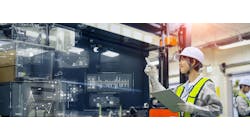With the refreshing of 80% of its enclosure business and the startup of a production facility in Haiger, Germany, Rittal has fully embraced Industry 4.0 and is a world-leading example to study in its application. In March, many value-creation 4.0 examples related to its digital processes, new compact enclosures and new smart factory were presented in Herborn/Haiger, Germany.
"Rittal's mission is to become the market and technology leader in industrial-enclosure-system solutions and data-center-system solutions," said Dr. Karl-Ulrich Koehler, chief executive officer at Rittal International. "Globally we are the market leader volume-wise, but there is much more to innovate, even with our own solutions. When we innovated the state-of-the-art industrial large enclosures last year, we didn't wait for someone who was chasing us. We tried to lead these things, which fits our mission."
And lead it has. Rittal has changed 70-80% of its core portfolio to new products. It started a few years ago with the efficient Blue e cooling units. Last year it introduced the VX25 large enclosure, which had advantages with its configuration systems and integrated digital support from the start. The large enclosure was very successful with 70% of customers converting from the previous TS product to its use in the first year. Rittal is confident that the same thing will happen with its new AX small enclosure line of products in mid-year 2019.
With 12,000 employees worldwide in 80 international subsidiaries operating with 1,500 patents and annual sales of more than $2.8 billion, Rittal looks like a best-practice business model to follow, especially related to innovation and Industry 4.0 and the digitalization and automation it feeds.
What's 4.0 all about? "It's not value itself; it's a very powerful tool," said Koehler. "Digital integration opens a sky of opportunities, but don't confuse it with the benefits of automation, for example, when you think in terms of productivity. Industry 4.0 is a tool that opens the way for new business models—value-creation 4.0."
A tailor-made data center from standard parts is an example. "That's what Rittal understands," said Koehler. "We use our system and combine the system solutions and add the engineering parts to make it work in an existing environment. In striving for our target of market and technology leader in our two fields, we have to first understand the customer processes, so we invest the time, understanding, discussions, visits needed to understand the customer's issues. We listen to customers' needs, we write ideas for innovations, and then we invest in order to get it done in a most modern fashion."
Rittal is involved with digitalization of three main areas. These areas include products and services; manufacturing and processes; and the value chain. Rittal provided examples of this industry-leading digitalization in the products and new production facility, as well as at Rittal's innovation facility, highlighting how it deploys this internally and with customers.
This modern fashion is highlighted in Rittal's new plant in Haiger, Germany. "This new plant provides the chance to try out a completely new way of manufacturing," said Koehler. "It's not just a smart-value-chain thinking and smart-order processing, it's also smart products and services. We have to make sure in our own fabrication that we demonstrate the latest state of the art. It's the philosophy of the company. In case of doubt, innovate the best of what you already have in the market. It takes courage and firepower to do that. Rittal has that and invests in that."
It's been a huge discussion process trying to find out what the benefits of digital innovation on a high standard of innovation are, continued Koehler. "The new facility has the latest start-of-the-art installation, producing the latest start-of-the-art product, the new, soon-to-be-released AX small enclosures," he said.
Rittal has tools at both the engineering and fabrication level that help the panel-builder, switch-gear manufacturer or data-center maker. "Rittal has developed machines to improve the efficiency of the large-scale panel builder," said Koehler. Combining that with its system of products creates the most optimal solution and saves a huge amount of time in the build shops. The product can be made faster, more reliably and with higher productivity while following ever increasing industry standards, he explained.
Many people today draw an enclosure on paper and then in the build shop make marks on a mounting plate to mount components or an enclosure for a knockout, continued Koehler. "If you start ePlan Electric eCAD software, in addition to the project planning, documentation and management of an automation project, a digital twin of the final product is created," he said. "This complete data set can be exported as orders to a machine that can cut the holes, crimp a ferrule and label the wires and display the system wiring steps on an HMI."
This raises the productivity of the skilled worker. "Rittal is helping the customer to optimize output," said Koehler. "It's not just with products such as the enclosures and climate-control systems, it's in the value chain, software and smart services. The feedback into our product development completes a permanent chain that helps to improve both our product and the processing of orders."
While the automation in the plant is quite impressive with many dozen robots and high-tech manufacturing lines, it's creating orders using its digital twin and other Industry 4.0 techniques. The orders are pushed down to the plant floor similar to MP3 songs in a play list. The orders are played in order on the automation, and it's a great song.






